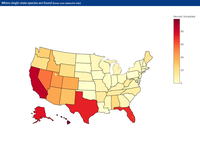
ESA Listed Species Found in a Single State
Proposals have been put forward to remove U.S. Endangered Species Act (ESA) protections from species found in only one state (intrastate species). Most ESA-listed species have limited ranges, which means most occur in a single state. Explore how many …Timeliness of Five Year Reviews under the Endangered Species Act
The U.S. Endangered Species Act requires a review of the status of listed species once every five years. Because of budget and personnel constraints, these five-year reviews are often behind schedule. This is a simple tool to view the timeliness of …Counties of Occurrence of ESA-Listed Species
The U.S. Fish and Wildlife Service provides tables of the counties of occurrence of each ESA-listed species, but they have no single table that compiles all species' data into a single location. We fill that gap with this simple, sortable, and …The Endangered Species Act 101
Learn how the Endangered Species Act (ESA) works in our new series! Meg Evansen, our Conservation Science & Policy Analyst, explains the Endangered Species Act in under 90 seconds in this helpful a series of primers. Click on the links and read …The Endangered Species Act 101: An Overview
In Part 1 of our ESA series, our Conservation Science & Policy Analyst, Meg Evansen, uses sea turtles to help illustrate why the ESA is essential for the recovery of endangered species.The Endangered Species Act 101: Section 4
Part 2 of our new ESA series breaks down Section 4 - an important section for giving Florida panthers and other species protections. Here, Meg explains how Section 4 helps endangered species move towards the ultimate goal of recovery.The Endangered Species Act 101: Section 7
Part 3 of the series explores how Section 7 helps recover endangered species like grizzly bears. Meg looks at how Section 7 provides solutions for both, grizzly bears and people, as we work to protect wildlife from extinction.The Endangered Species Act 101: Section 9
In the final chapter of our ESA series, Part 4, Meg walks through Section 9 of the Endangered Species Act. She uses whooping cranes as an example of how these protections make sure that listed species are afforded the opportunity to recover.A definition of 'habitat' under the ESA
The Supreme Court’s opinion in Weyerhaeuser Co. v. United States Fish and Wildlife Service, 139 S. Ct. 361 (2018), raises important questions about the scope of the Endangered Species Act's protections for critical habitat. In a short ruling, the …